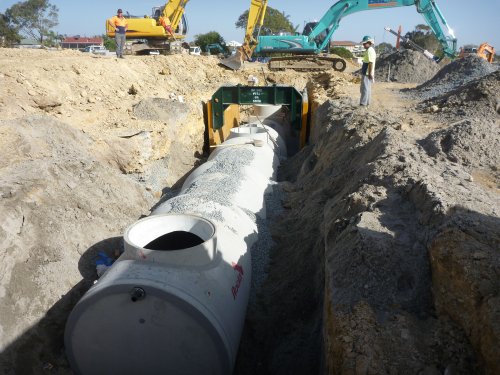Ambitious water re-use strategy for luxury development
Friday, 24 June, 2011
Salacia Waters, one of the largest urban developments on the Gold Coast, Queensland, is setting regional benchmarks in both community planning and environmental responsibility.
The $650m residential development is located on the last undeveloped peninsula at Paradise Point, on a long-vacant 10.8 ha site. The first stage includes five apartment buildings with 131 luxury apartments, as well as commercial space and landscaped recreational areas. The development will ultimately comprise 470 apartments and villas, as well as a private marina, shopping and dining precinct and residents’ facilities.
A strong emphasis on sustainability and water-sensitive urban design was incorporated into the master planning. A state-of-the-art water re-use strategy was designed by principal civil engineers Hyder Consulting to reduce loading on the Gold Coast City Council infrastructure and provide maximum use from harvested rainwater.

At the heart of the re-use system is a series of Rocla underground concrete water storage tanks providing a total of around 600,000 L of storage capacity, installed by civil contractors Peachey Constructions.
Rainwater harvested from the roofs of apartment buildings and villas will be stored in the tanks for toilet flushing and vehicle washdown. In total, 230,000 L of Rocla ecoRainPlus tanks are located beneath the pavement of the private road system in a combination of 40,000 and 30,000 L units.
In addition, a stormwater treatment train has been designed that not only complies with performance criteria, but does so aesthetically through the use of underground collection tanks, gross pollutant traps and bioretention zones incorporated into landscaped areas with pressurised discharge heads delivering stormwater for treatment.
As a back up, the roadway rainwater storage tanks are provided with metered cold water top-up from the potable water supply.
Villas not serviced by the roadway collection tanks will be provided with 5000 L rainwater harvesting tanks located beneath or within the building’s garage. Overflow from these tanks will discharge to the stormwater drainage system and then to the trunk stormwater drainage system, where it will be conveyed back through a bioretention system before discharge to the waterways.
Collectively, the stormwater tanks will provide the site with a volume of internally re-usable water above the council’s standard requirements.
Excess capture from the roadway tanks will not be wasted, but will be conveyed via a separate network to central Rocla ecoRainPlus tanks with a capacity of 120,000 L for re-use as irrigation. All open space and landscape areas will be irrigated from rainwater harvested from the site.
The stormwater reticulation network will receive stormwater from the entire site, including overflow from the re-use systems and general site run-off. The reticulation system will drain the site via a network of Rocla reinforced concrete pipes and Rocla Q-KIS pit inlet structures and maintenance holes before ultimately discharging to a total of four outlet locations at each of the four ‘corners’ of the site.
At each of the four outlets a diversion structure will divert flows through one of four Rocla CDS Unit gross pollutant traps (GPTs). After removing the necessary levels of litter, sediment, suspended solids and hydrocarbons, the stormwater will be captured via one of four 63,000 L Rocla EcoRainPlus collection tanks.
Pumps and pressurised pipe networks in the four 63,000 L tanks carry water to bioretention areas at a rate equivalent to the hydraulic capacity of the bioretention system. This network has been carefully designed to ensure that treatment of the run-off is equivalent to a system without pumps.
In total, three bioretention areas are included in the treatment train, which receive stormwater from all four 63,000 L tanks. The total contributory area of the bioretention is more than 880 m2 and is incorporated into a landscaped area with walkways.
After adequate treatment for stormwater quality from the combined treatment train of re-use tanks, gross pollutant traps and bioretention areas, stormwater is discharged from the site to the adjacent Coomera River and Broadwater waterways. Backflow prevention devices ensure the performance of the stormwater treatment system in all tidal conditions.
With the assistance of the Rocla stormwater collection tanks, CDS Unit GPTs, reticulation and bioretention areas, all environmental values and water-quality objectives are being satisfied.
Data centres working to use water responsibly
Decisions that go into designing a new data centre will stay in place for many years to come, so...
Acoustic analysis helps protect a high-risk asset
A collaboration between Scottish Water and water solutions provider Xylem has netted a...
Future Made in Australia needs water to make it happen
Boosting technologies and manufacturing for a Future Made in Australia could get off to a healthy...









